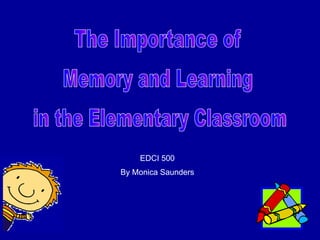Memory
- 1. The Importance of Memory and Learning in the Elementary Classroom EDCI 500 By Monica Saunders
- 2. Sensory Memory Working Memory Long-Term Memory Sensory Memory: Is everything we see, hear, taste, and smell. This data can be held in memory for about three seconds. Working Memory: Temporarily stores and actively processes data from Sensory Memory. New data is combined with old data to try to make sense of new data. It can hold data for as long as you pay attention to that data (about twenty seconds or five to nine items). Long-Term Memory: Data is stored here for life-use. It is stored in away that links data up so that it is meaningful to a particular person. It can hold information almost indefinitely. How Memory Works:
- 3. Attention Everyone! We will not remember what we do not pay attention to! Here’s what to do: Use signals to get student to stop and listen. Use proximity and student’s name while giving lesson. Avoid disruptions Props, props, props! Use surprise events like Clifford coming to class to help learn about the color red. Use thought provoking questions like “What would you do if you couldn’t find our classroom?” Use various sensors to teach material. Not just hearing. ?
- 6. “ Now it’s time to think, think, think!” Teaching Meta-Cognitive Skills Meta-Cognition deals with how we plan, comprehend, and solve problems. At Freedom Middle School in Spotsylvania, Virginia they help their student’s to learn Meta cognitive skills by employing the “ High Five” strategy . Connect Communicate Solve Plan Think Think : What is the problem? Plan: What will I do to solve this problem? Brain Storm! If needed, how will I show my work (draw, tally, do it in my head, etcetera) ? Solve: Do the problem. ACTION! Communicate: Were you successful with the problem? If you did it in your head, what were the steps used? Connect: Relate to the problem. How can I use these steps to solve other problems?
- 7. Where learning fails in the classroom: There are three types of long-term knowledge: 1. Declarative : Specifics we know about a topic. 2. Procedural : The “how to” that we know about a topic. 3. Conditional : The conditions of when we use a topic. For example, I may know what a bike is (Declarative knowledge) but, do I know how to ride a bike (procedural) or not to ride a bike on ice (conditional)? Implications: Let’s talk S.O.L.s: Some teachers fall into the trap of spending too much time having students memorize S.O.L. facts. Not only is this generally meaningless to the student but, it does not show the student Procedural or Conditional knowledge which is essential for applying what we have learned
- 8. Memory Strategies Sometimes we just can’t get around memorizing. So the rest of this presentation is designed to aid you in teaching various memory strategies to your students…. Chunking is one of the most useful strategies . Chunking is used with our social security number and our telephone numbers so that data is more easily managed. For example, Lets say that I need to remember the first fifteen digits of Pi. That’s 3.1415926535 HELP! My memory can only handle five to seven bits of data at a time. What do I do? I chunk or group my data into easily managed units. Regrouping my data , I get 3.14 1592 6535 Now you have stored three data points where there was eleven!
- 9. More Mnemonics! Peg words: Associating words with a place in the rhyme below. This is helpful when you have to remember things in a particular order. For example, the list to r remember in order could be; turtle, crocodile, cat, elephant, and dog. Rhyme Peg Association One is Bun A turtle eating a bun Two is shoe a crocodile chewing a shoe Three is tree a cat up a tree Four is door an elephant crashing through a door Five is hive a dog playing under a hive Chain Mnemonics : Link items together. Connect the first item with the second with the third and so on. For example: Using the words: Mary, cup, soda, and pillow we can come up with “Mary’s cup of soda spilled on the pillow.’ Acronyms : What would we do with out them! Acronyms are abbreviations that stand for something. Such as T.V. stands for television. These can also be in the form of trigger sentences like: “ Every Good Boy Deserves Fudge” which stands for the musical scale EGBDF. Rhymes and Jingles: They really do stick in your head! How did you first learn the order of the alphabet? Through the Alphabet song! Cho Cho Soul has some great educational songs. Check it out!
